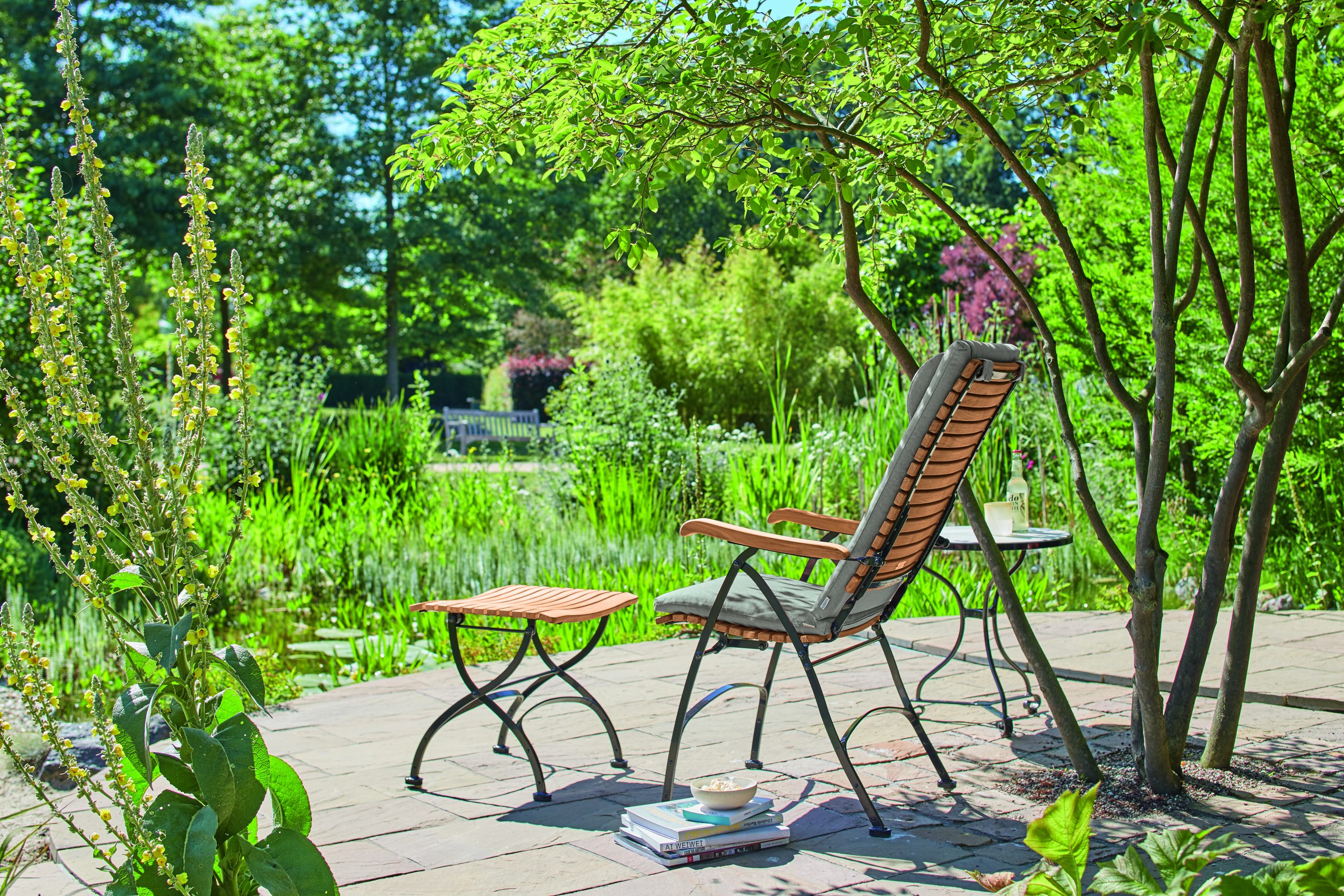Like a big wandering cloud that scoots in front of the sun, or a surprise dinner guest bearing bubbly, a patio umbrella provides instant relief and refreshment on a sweltering summer day. While wicker loungers by the pool or a rustic teak dining table might take center stage in your outdoor living area, modern shade solutions are designed to unfurl quietly and elegantly, year after year, providing adjustable all-day shade and protection from rain and wind.
This guide is intended to orient you to all of the many styles, sizes, shapes, features, and components of commercial and residential patio umbrellas and other shade systems, as well as take you through all the decision points involved in the buying process. By the time you reach the end, you will have the confidence to purchase the perfect patio umbrella and all necessary accessories online.
- Popular Patio Umbrella Styles
- How to Choose the Right Umbrella for Your Space
- Umbrella Construction: Materials & Components
- Umbrella Operation: Lift & Tilt
- How to Choose the Right Umbrella Mount
- Compare Umbrella Models at a Glance
- Other Shade Solutions
- How to Clean Patio Umbrellas?
- Patio Umbrella Accessories
Popular Patio Umbrella Styles
The traditional market umbrella, also known as a center-pole umbrella due to its centrally located pole, resembles a larger ground-mounted version of the time-honored handheld umbrella. The pole, historically made of wood and also known as the mast, is located directly beneath the canopy dome.
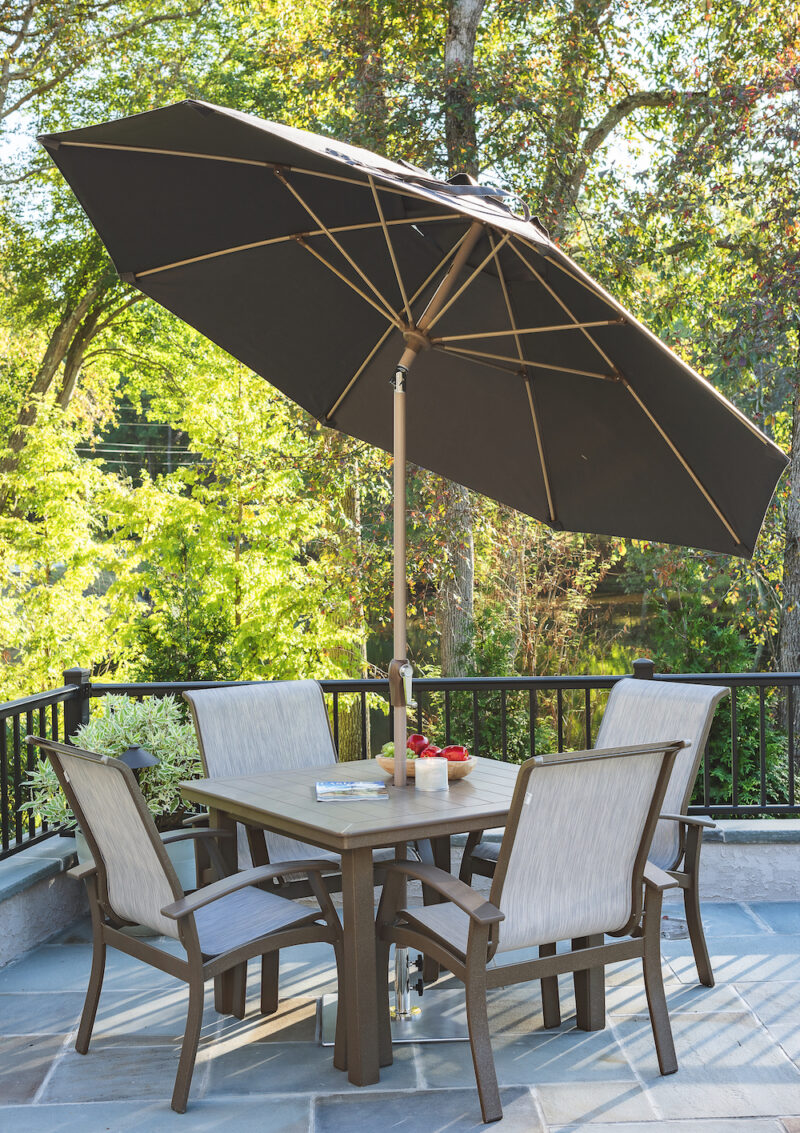
The handheld umbrella has its roots in antiquity, when royal retainers would hold up a parasol (translation: protects against the sun) to shield the complexions of VIPs. The modern rain umbrella originated centuries later in gloomy Victorian England. The blueprint for the modern design sported whalebone ribs and an oiled silk or paraffin wax-coated cloth canopy. Much like pince-nez glasses, these early rain umbrellas were a largely ineffective, yet fashionable, status symbol.
Over time, more practical construction emerged and retractable steel ribs allowed the canopy to open and close. These innovations led to mass adoption, and by the 1870s fixed umbrellas protected patrons of London coffee shops. They earned the moniker “market umbrella” because they were towed along to open-air markets to shade merchant stalls.
The commercial market umbrella moved across the pond to become today’s patio umbrella in the 1950s when “keeping up” meant having a cooler and shadier backyard oasis than the Joneses in the booming American suburbs. The residential patio umbrella was secured either by a free-standing base or mounted through the parasol hole of an outdoor dining table.
Umbrella innovation didn’t stop there. The most recent iteration of the patio umbrella is the cantilever, or offset, umbrella. In this style, the mast is structurally removed to the side of the canopy. This inverted L-shaped support makes the canopy more maneuverable on multiple axes for improved shade coverage and directional shade throughout the day.
Comparison: Cantilever vs. Market Umbrella Styles

Footprint
Market umbrella canopies come in all shapes and sizes, ranging from 6 to 16 feet wide. Resorts and restaurants favor giant market umbrellas, with canopies 13 feet and larger supported by heavy bases or fixed mounts. On the other hand, most market umbrellas for residential customers are relatively lightweight, weighing less than 100 pounds with a base.
Cantilever umbrellas can be significantly heavier. They range from 8 to 13 feet wide and require a base of 400 pounds or more to support the remote canopy’s offset center of gravity.
Performance
Cantilever umbrellas justify their larger footprint (and price point) by offering enhanced canopy maneuverability. A cantilever umbrella with a 360-degree rotating base provides shade to up to four times as much space as a comparably sized stationary market umbrella. The canopy’s vertical and horizontal tilt functionality allows you to provide directional shade anywhere within that radius as the sun moves overhead throughout the day.
Cantilever umbrellas have an additional advantage in that the shadow they provide is largely free of obstructions. A market umbrella, even if it is secured within the umbrella hole of an outdoor dining table, does require you to arrange your patio furniture relative to the central pole and base of the umbrella.
How to Choose the Right Umbrella for Your Space
Selecting the right shade solution for your space requires more than deciding between a cantilever or market style of patio umbrella.
To determine the best umbrella for your outdoor oasis, you will need to measure the dimensions of the outdoor space you wish to shade. These measurements, in addition to your overall aesthetic, will largely dictate what style, frame, size, and canopy shape you require.
Canopy Shape
The canopy is the fabric shade material that is secured to the pole via retractable ribs connected to two moving hubs that open and close the umbrella. Canopies typically come in three shapes, each with a unique use case depending on your space.
Round & octagonal canopies are ideal for compact circular spaces such as hot tubs, circular sofas, dining tables, fire pits, bar tables, and groupings of poolside chaise lounges.
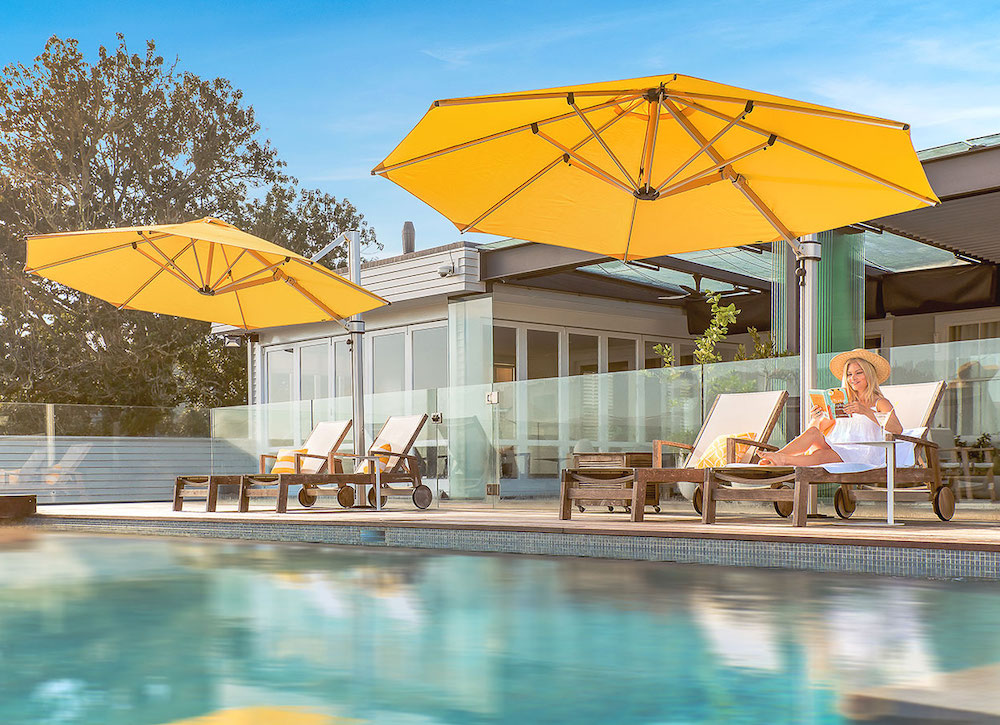
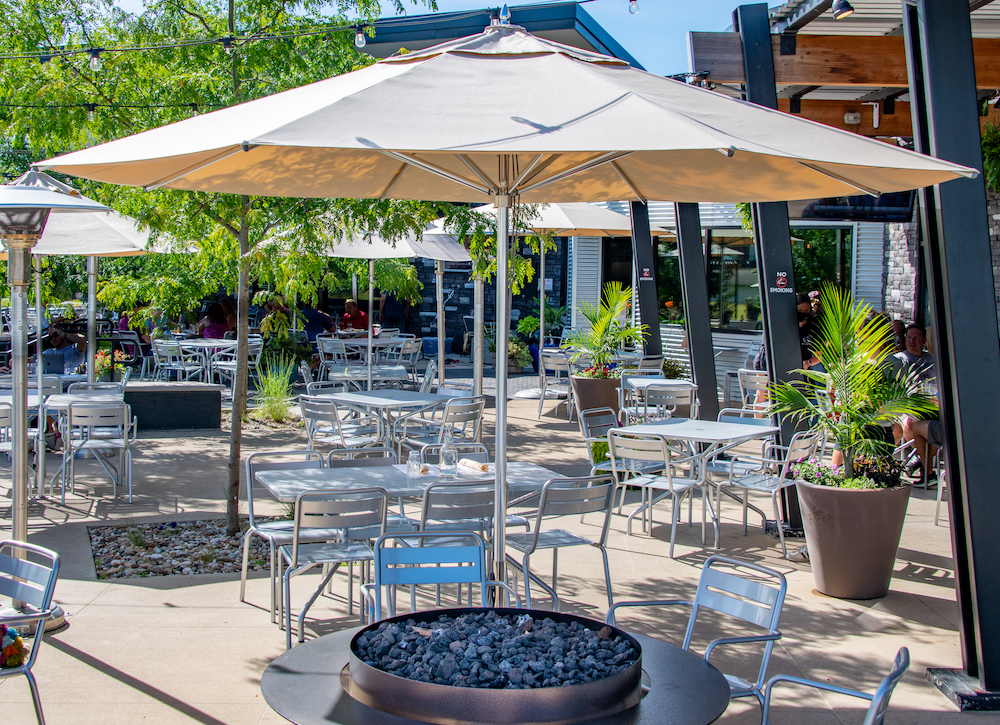
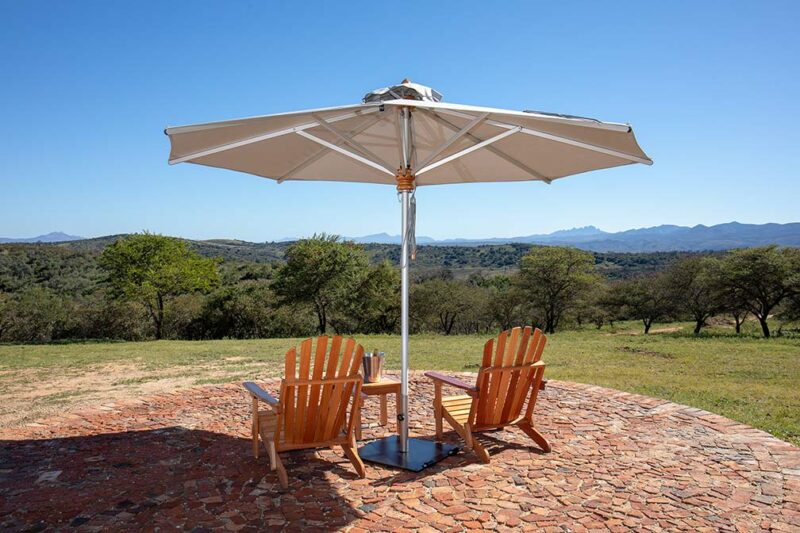
Square canopies are bulkier but provide maximum shade coverage for symmetrical set-ups such as bistro tables, square dining tables, and lounge seating islands anchored around a coffee table.
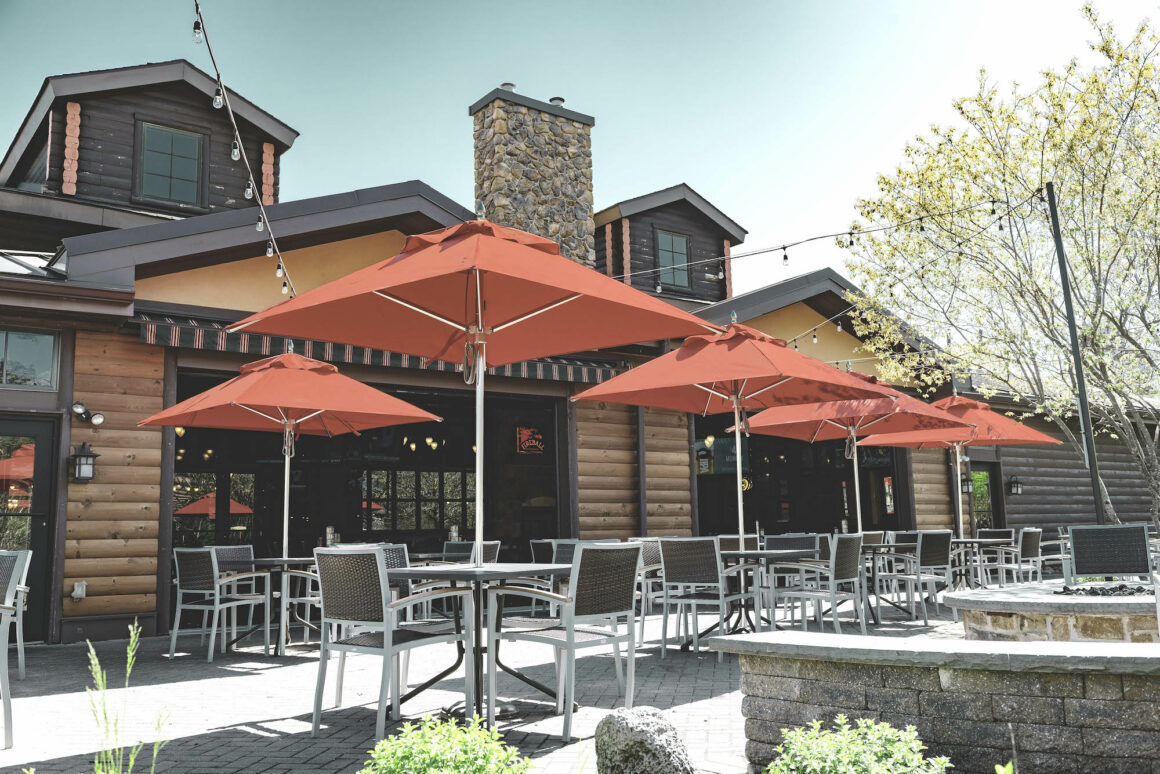
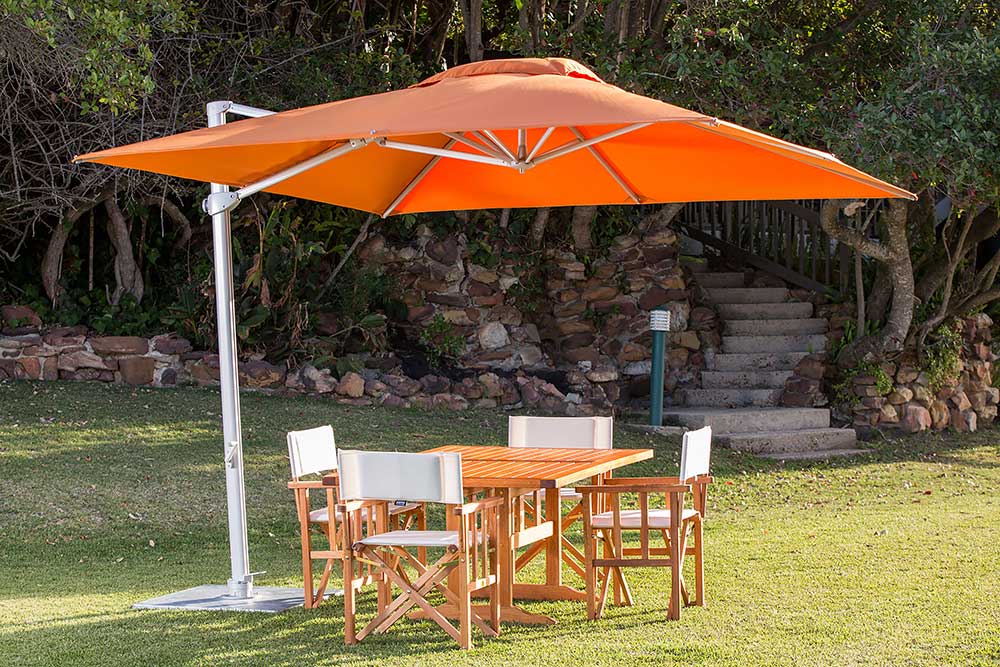
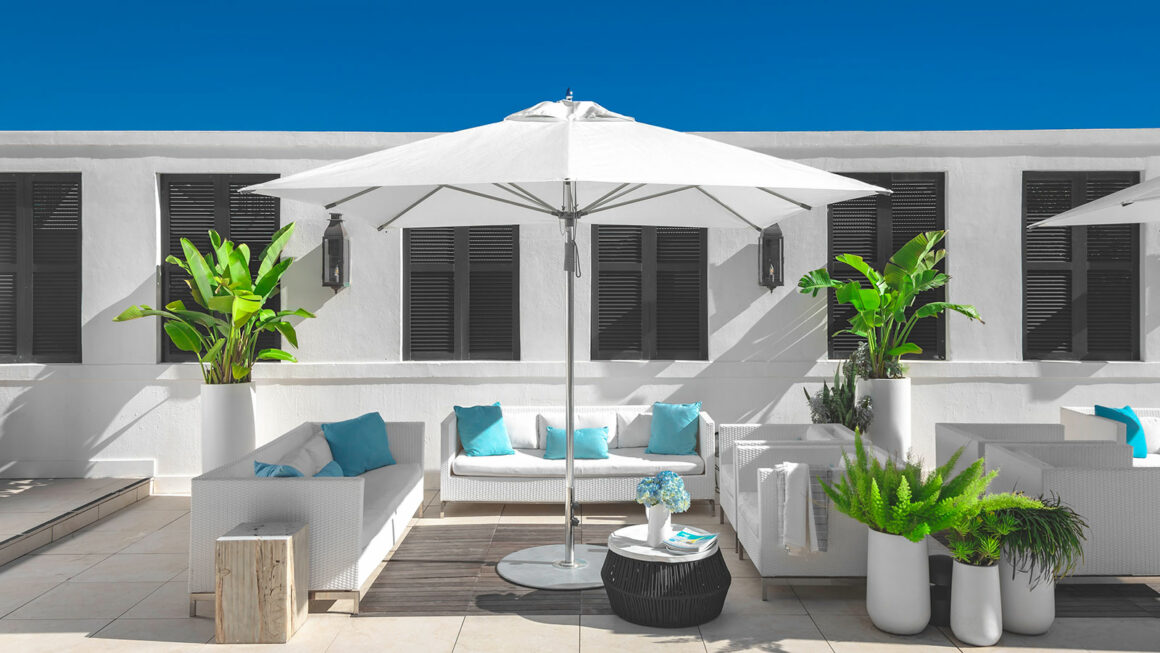
Rectangular canopies are less common, but are ideal for asymmetrical furniture layouts such as long rectangular or oval tables and extended sectional sofas.
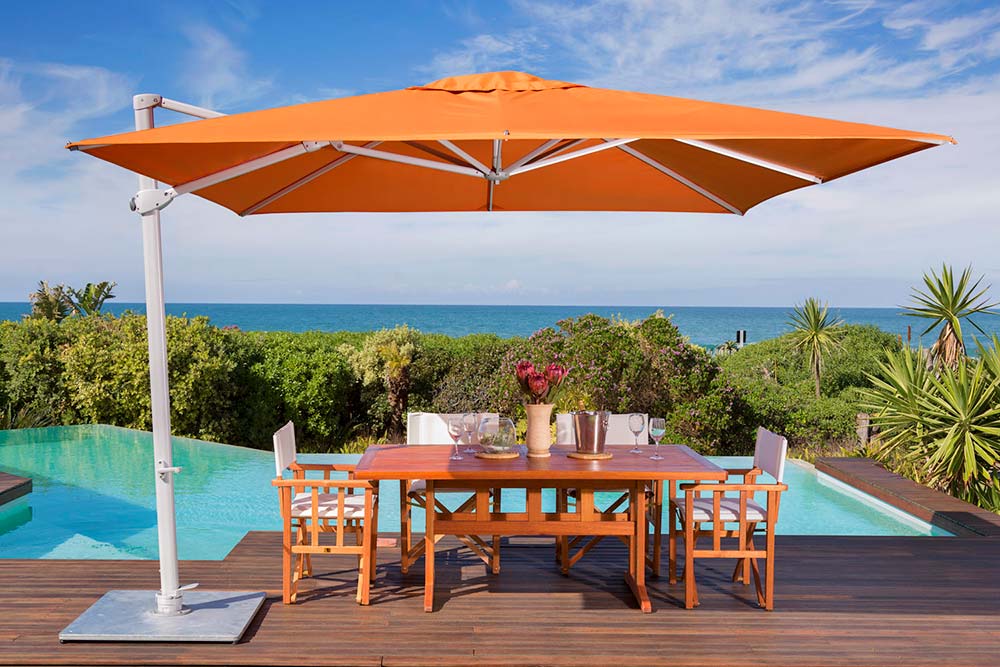
Canopy Size
Your ideal canopy size will vary based on canopy shape and the measurements of your outdoor living space. Below are a few examples of common outdoor dining and lounge configurations and the recommended shape and dimensions for the appropriate umbrella canopy.
Round/octagonal canopy: Add 4 to 5 feet to the diameter (widest point across) of the area where you want consistent shade.
Square canopy: Measure a perimeter side of the area where you want consistent shade and add 2 to 3 feet to obtain the correct canopy width.
Rectangular canopy: Add 2 to 3 feet to both the length and width perimeter sides of the area you want to shade.
Why the Difference in these Calculations?
The reason that the calculations differ based on canopy shape is due to a quirk in how umbrella manufacturers measure and list canopy dimensions. As shown in the diagram below, round umbrella canopies are measured from tip to tip across the diameter, whereas square and rectangular canopies are measured along their perimeter sides.
This can lead to the mistaken impression that round or octagonal umbrellas are larger because their widths are listed as larger. But, as shown below, a square umbrella listed at a smaller width actually has a larger radius and potential shading area than an equivalent round canopy.
Because the ribs on square umbrellas extend out further, they tend to be taller than round umbrellas. In some cases, they even have less ground clearance when the canopy is closed. Therefore not all square market umbrellas are suitable for use with a table. Check the manufacturer’s figure for “closed clearance” to see if an umbrella will work with your outdoor dining table. (Note: some of these figures for Curran umbrellas are included in the table below.)
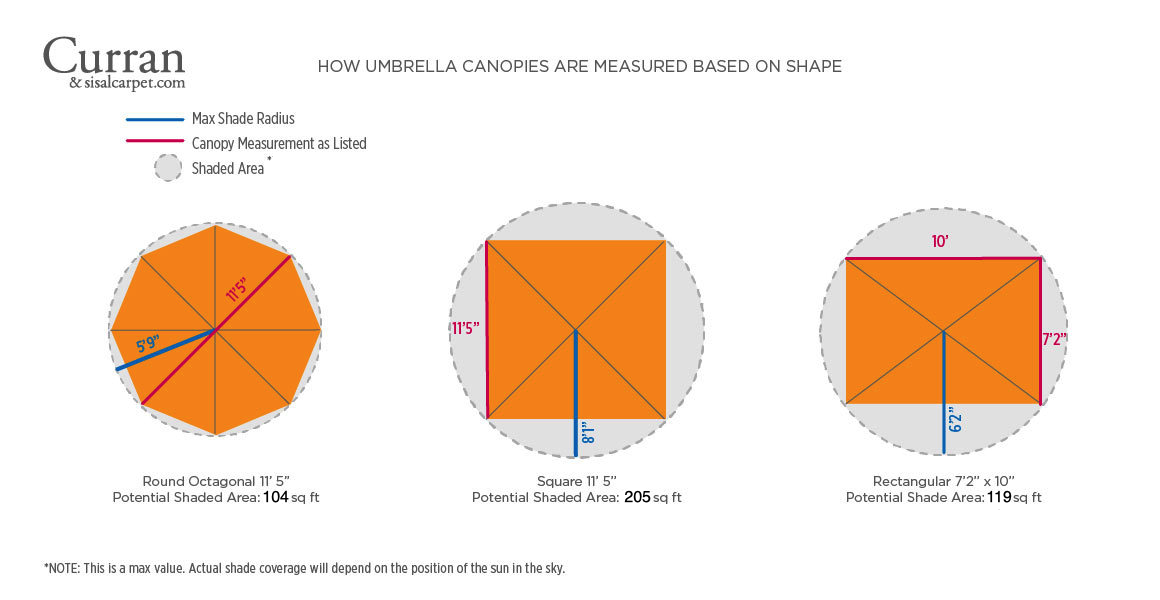
Rectangular patio umbrellas are measured by the width and length of their perimeter sides. Position the canopy with care to make the most out of the shaded area. For a non-rotating rectangular market umbrella, consider the angle of the sun when the umbrella is most likely to be in use, such as at lunch or dinner time.
Position the umbrella base with the long end of the canopy extending towards the sun at the busy time of day, otherwise, your long table might not lie directly in the path of the resulting shadow.
One final note: nailing the correct positioning is even more important for all fixed-mount umbrellas, such as deck mounts and in-ground mounts, so make sure to plan everything in advance.
Umbrella Construction: Materials & Components
Now that you’ve considered the style, canopy shape, and size of umbrella you require, it’s possible to narrow down further to the ideal umbrella model. Pricing for a particular umbrella collection is determined by the quality of building materials as well as the functional features of the umbrella’s operation. This will be explained in much greater detail in the following topics which are common to all shade solutions.
Canopy Innovations
Thanks to improved mechanics and high-performance materials, modern patio umbrellas are lightweight and maneuverable, increasing their effective shade range while reducing their bulky structural footprint. Today’s shade solutions have fewer moving parts and manual controls, making them more user-friendly, easier to maintain, and more durable.
Designers have also reimagined what a shade solution looks like. For example, Umbrosa’s ultra-modern Versa UX cantilever style umbrella combines graceful useability with a flat canopy and spare elegant silhouette that deconstructs the traditional umbrella by eliminating anything which would appear to be extraneous.

Umbrosa’s Paraflex collection is a modular system for mounting multiple canopies (2-5) to one pole, or mounting individual canopies to a wall.
Fabric
Modern synthetic canopy fabrics are built to withstand wind, rain, and UV radiation from the sun. All our fade resistant patio umbrellas use solution-dyed acrylic fabric yarns are infused with color at the molecular level to be 7/8 colorfast. The treated woven fabrics are water-repellent, as well as mildew- and stain-resistant. Our selection includes high-performance acrylics from Sunbrella, Solidum, and Recacril. Below are a few considerations:
Improved water resistance: We recommend Frankford umbrellas, which feature marine-grade 9 oz. fabric that is easy to clean, resistant to mold and mildew, and won’t sag or stretch over time.
High wind strength: Consider our Woodline Storm umbrellas (along with Frankford Nova one of our best patio umbrellas for wind) which feature reinforced canopy stitching to create strong seams and tear-resistant eyelet-holes for the stainless steel fasteners.
Branding: Commercial clients who would like logos or other branding printed on their umbrella canopies, can contact our customer service team. Both Woodline and Frankford umbrellas offer screen and digitally printed customization.
Wind Vents
Most umbrella canopies feature at least one wind vent, a flap of fabric that rests above the dome and under the finial. Air travels through the wind vent, giving sudden wind gusts a path to travel, thus increasing the umbrella’s stability. A wind vent also allows hot air to escape upwards, cooling the area beneath the dome for those seated below.
Some models with heavier-duty fabrics feature double wind vents. These help in high-wind environments such as rooftops and beaches, or for larger umbrellas where the extra vent can help keep the canopy stable.
Finials
A decorative adornment that sits atop the canopy. Available in different finishes such as polished chrome for a classic statement.
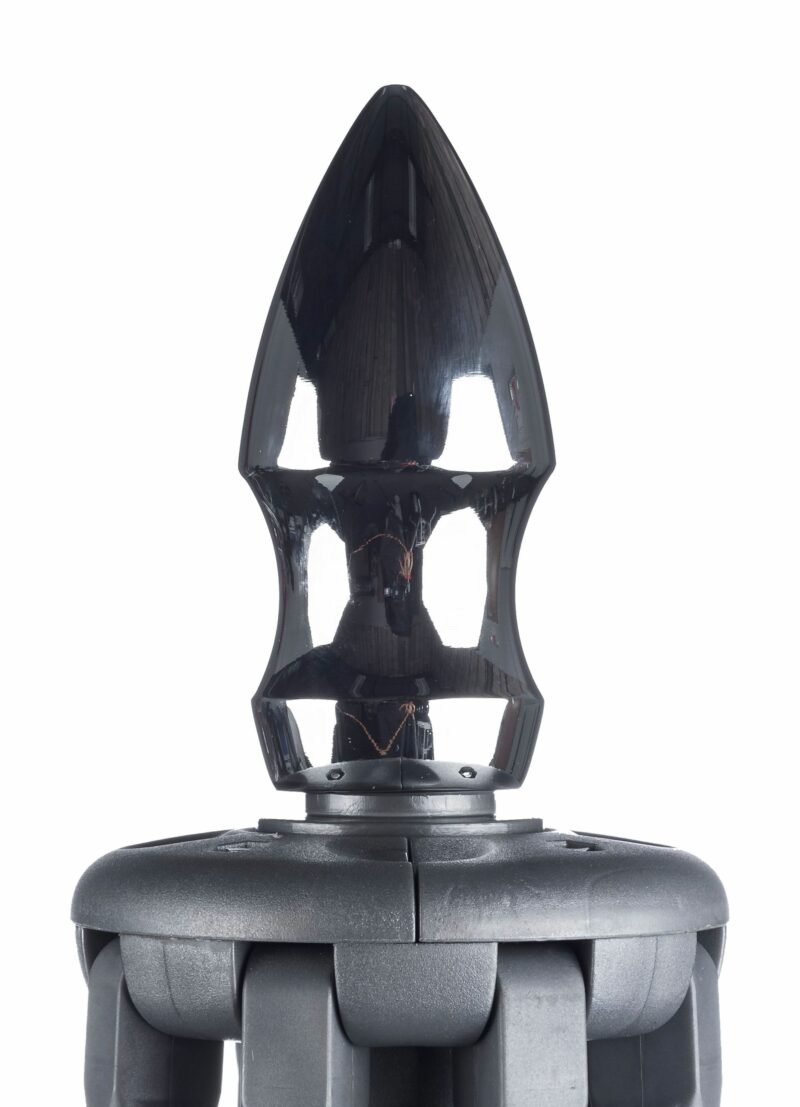
Frame Mechanics
Beneath the fabric canopy is the umbrella frame, which constitutes the ribs, pole, and lift mechanism. While the cut and color of your canopy may be the first thing to catch your eye, the frame can also express your design style.
The quality of materials used in an umbrella frame determines the umbrella’s durability. From the mast to the ribs and hardware components, skilled craftsmanship and resilient materials will provide the greatest benefit to the overall longevity of an umbrella. This is especially important for high-use commercial environments such as resorts and restaurants, windy areas, and seaside locales. For our premium commercial grade umbrellas, many of these components are user-replaceable, substantially lengthening the lifespan of the umbrella (typically 4-6 years of everyday use) as failed components can be swapped out instead of replacing the entire umbrella.
Pole/Mast
Poles should be sturdy to secure a large canopy to a firm base. Market umbrellas have a standard pole width of 1.5” to 2.5”. The Nova Giant Patio Umbrella is a commercial grade wind resistant patio umbrella from Frankford that has a much thicker pole at 4” wide. This thicker mast supports an umbrella that reaches 14’ high and that can withstand winds of 50 mph. Most cantilever umbrellas have a mast between 3” to 5”.
Anodized Aluminum
The majority of our aluminum patio umbrellas have a pole constructed from anodized aluminum. Aluminum is an extremely strong and rigid metal proportional to its weight. Anodization is an additional electrochemical process that the aluminum undergoes during production that utilizes electrical current to extract oxygen from within the metal to form an impermeable base layer of aluminum oxide on the surface of the metal. The resulting porous substrate deeply absorbs pigments to create a finish that retains its color and polish and can’t be rusted, tarnished, or scratched.
Examples: Woodline Easilift, Frankford Greenwich, Umbrosa Spectra
Wood
We also carry wood umbrellas for aficionados of the classic market umbrella or rustic country garden look. Constructed from sustainably-sourced high-tensile strength eucalyptus or other premium hardwoods, wood-framed umbrellas are a renewable alternative to metal that complements patio decking and teak patio furniture.
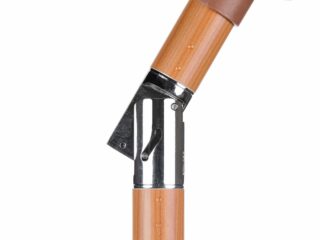
Examples: Barlow Tyrie Napoli, Woodline Safari, Frankford Monterey
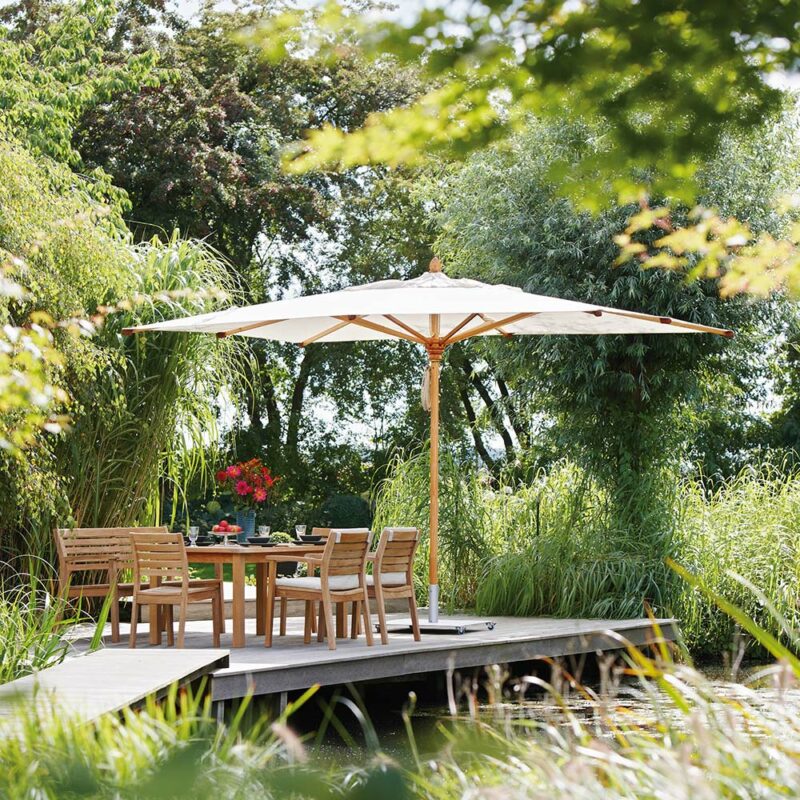
Telescoping Pole
A market umbrella with a telescoping pole will lift up as you close the umbrella so that the canopy closes above the umbrella hole of an outdoor dining table or any other furniture positioned underneath.
Examples: Barlow Tyrie Napoli, Woodline Swift, Frankford Nova
Ribs
Ribs are the structural joints that connect the pole to the canopy. Secured to upper and lower hubs and extending to the outer tips of the canopy, these connectors are pushed upwards to open the canopy or drawn down to close it. Most ribs are either made of aluminum which is rigid but strong and lightweight, or fiberglass, which is much more flexible.
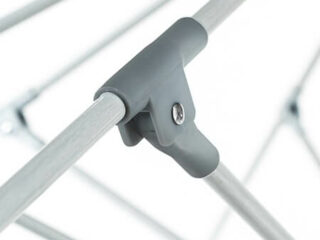
Fiberglass
Typically used to construct ribs for umbrellas with excellent wind performance. In windy conditions, the ribs are designed to bend rather than break which reduces stress on the canopy fabric and fasteners. This reinforcement decreases the possibility of your umbrella turning into a sail.
Examples: Frankford Monterey, Umbrosa Versa UX
Hubs and Other Frame Components
The upper and lower hubs house the upper and lower ribs which connect the pole to the canopy, and move up and down to open and close it. Hub components are typically steel or aluminum, and sometimes synthetic composite materials are included if they are meant to be manually handled as part of the lift mechanism of the umbrella.
Stainless Steel
Typical for construction of the hubs and moving parts, as well as fasteners, hardware, grommets and other components. Marine-grade stainless steel is intensely strong and resistant to chlorine (pool water), acid rain, salt water, and rust. The process of polishing makes the material less susceptible to dirt. These properties make marine-grade stainless steel umbrellas a natural choice for seaside resorts and villas.
Examples: Woodline Storm, Umbrosa Paraflex, Frankford Eclipse
Umbrella Operation: Lift & Tilt
Lift Mechanism
While all umbrellas require some degree of manual effort to open, close, tilt, or rotate, newer more advanced models are increasingly automated and sophisticated.
There are three common mechanisms for hoisting and furling the canopy: manual, pulley, and crank.
Manual Umbrellas
Push: Similar to a handheld umbrella, one pushes up on the hub until the umbrella engages the lock or is secured in place by a locking pin.
Fan: A relatively new and innovative way to open and close umbrellas. Only found on our Umbrosa models.
Examples: Frankford Catalina, Umbrosa Versa UX
Pulley Umbrellas: In this style, you pull on a rope hanging beside the pole which is connected to the hub via a pulley. Once you have raised the canopy to its full extension, you can secure the lower hub with a locking pin.
Examples: Woodline Bravura, Frankford Greenwich
Crank Umbrellas: Common with taller umbrellas and heavier canopies. In this system, the crank does much of the work to raise and lower the canopy. By turning the hip-level manual crank, the canopy raises and after the canopy has been fully extended, locks into place on its own.
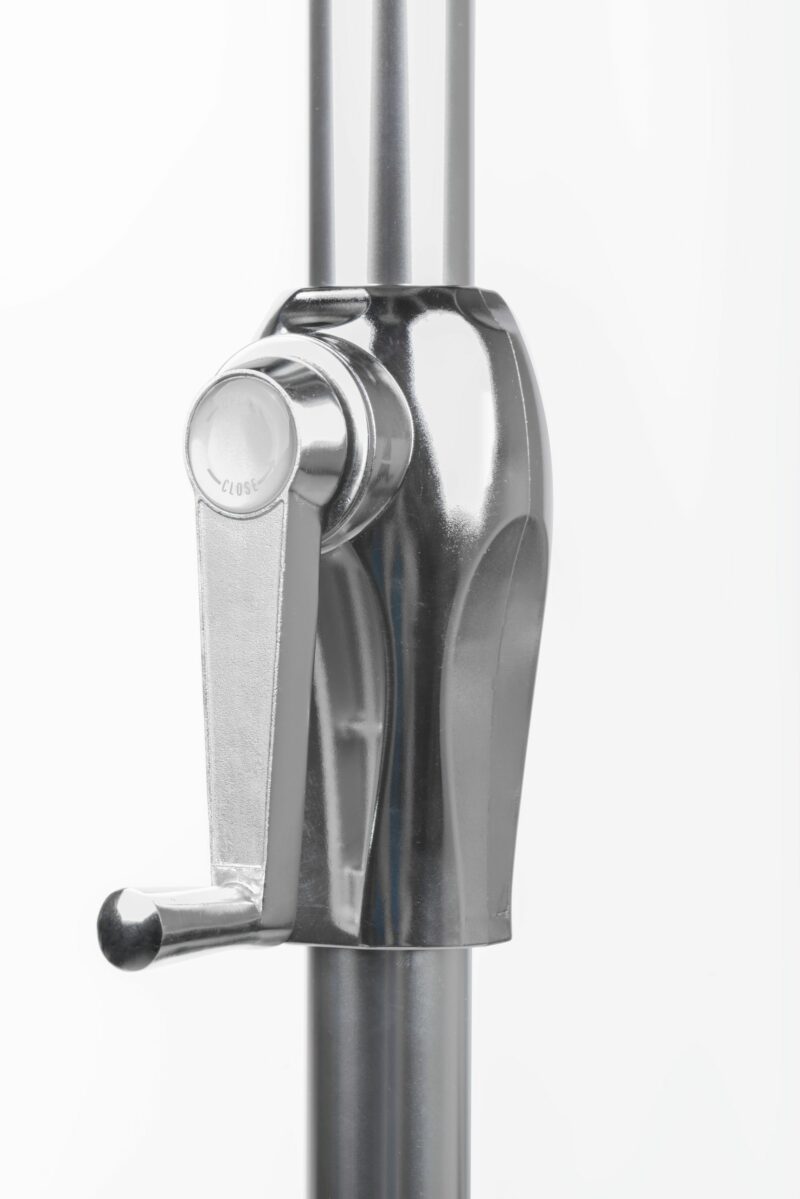
Some models, such as the Frankford Monterey Auto-Tilt, allow you to continue cranking to tilt the canopy past vertical to provide directional shade. The Auto-Tilt is, like all Frankford umbrellas, specifically designed and warranted for commercial use.
Frankford’s Nova has a removable crank that improves the line of sight across a crowded dining table. If you buy an umbrella without a detachable crank, make sure the crank is high enough on the umbrella to clear the table parasol hole.
Examples: Frankford Monterey Crank Auto-Tilt, Woodline Pavone
Self-Opening Umbrellas: Woodline’s new Easilift umbrella has a self-lifting hub that engages after gently lifting up on one of the ribs. The umbrella raises to its maximum height and self-locks into place. When you are ready to close the umbrella, simply pull down on the hub and stand aside while the umbrella lowers and secures into place.
Examples: Woodline Easilift, Royal Botania Palma
360 Degree Rotation
Most cantilever umbrellas are equipped with a rotating base to allow full 360-degree canopy rotation. This effectively quadruples the potential shading radius of your umbrella. Via foot pedal or another style of release lever, one can easily spin the umbrella’s mast on its bottom axis to position the canopy over any patio furniture within the umbrella’s radius.
Examples: Woodline Pendulum, Umbrosa Spectra, Frankford Aurora
Tilt
Many market and cantilever umbrellas include tilt technology to provide directional shade as the sun angles overhead throughout the day.
Market umbrellas typically have a crank or push button beneath the hub to adjust the canopy angle past vertical in a specific direction. Crank auto-tilt models cause the canopy to tilt by continuing to crank after the umbrella has fully extended. In another model, the Napoli from Barlow Tyrie tilts by rotating one of the ribs in a clockwise direction, as if you were spinning a fan by hand. You do the reverse to return the canopy to the fully-upright position.
Examples: Frankford Catalina, Frankford Crank Auto-Tilt
Cantilever umbrellas typically have a sliding guide that travels up and down the mast to provide vertical tilting of the canopy. The Woodline Picollo is a unique cantilever umbrella in that the canopy can be positioned omnidirectionally. The canopy is suspended from an overhanging armbar allowing it gyroscopic freedom of movement.
Some cantilever umbrellas, like Woodline’s Pavone, have foldaway canopies that can be fully retracted and collapsed to rest flush against the mast, increasing space-efficiency for this typically bulkier style.
Examples: Umbrosa Versa UX, Frankford Eclipse
How to Choose the Right Umbrella Mount
Patio umbrella bases are typically not automatically included in the umbrella purchase. While many umbrella models have a recommended base (or bases) to support the performance of the umbrella, such as Frankford Nova or Woodline Storm, other collections can choose from an array of free-standing (mobile or not), or fixed mount (in-ground or deck-mounted options).
A very important first consideration is to make sure that the base’s stem is compatible with the umbrella pole’s width. Most market umbrella bases will support either a 1.5″ or 2.5″ pole, so check the dimensions of your umbrella pole.
Next, decide if you would like a free-standing base or fixed mount. Read on for more details of both. And if you find any of this daunting or confusing, you’re not alone: reach out to our helpful customer service team for support.
Free-Standing Base
Cantilever umbrellas require a significantly heavier base (up to 400 pounds or more) to correct for the center of gravity being displaced by the remotely suspended canopy.
A smaller model market umbrella might be able to be secured with a relatively light base (35 pounds), especially if the pole is additionally buffered by the center umbrella hole of an outdoor dining table.
The larger the canopy, the greater pressure that can be exerted upon it by wind, and therefore the heavier the base required to provide stability. Consult the table below for a rough estimate of the recommended weights for a freestanding base based on canopy size, umbrella style, and environmental conditions.
Outdoor Dining Table with Parasol Hole
Only an option with lighter market umbrellas, typically with a mast 2.5″ or thinner. Securing the mast through the parasol hole of an outdoor dining table will effectively halve the weight you require for the free-standing base beneath. Two crucial considerations for a patio umbrella mounted in this fashion: what is the height of the crank (if there is one), and the “closed clearance,” or measurement between the ground and rip tips of the canopy when closed above the table? Many square market umbrellas (see table below) do not provide sufficient clearance for the average height outdoor dining table with a parasol hole (typically 28″- 30″).
Mobile Base
A patio umbrella stand with wheels. This is a good option for small to mid-size market and cantilever umbrellas because you can wheel the umbrella around your outdoor living area, giving you the option of staying in place throughout the day or moving where you like. Wheels can be locked in place or removed if desired.
Concrete Slab/Paver Base
A good option because the base itself is easier to move around and less expensive to ship. Use pavers available from your local hardware store to manually add as much weight as needed to secure the base.
Pro Tip for Concrete Pavers: Concrete pavers recommended for certain umbrella collections can be of mixed sizes. In the case of our imported model umbrellas (Woodline and Umbrosa), there can sometimes be a discrepancy between the manufacturer’s specified sizings and sizings that are typical for the American domestic market. Check out the hardware or concrete store websites for slab weights and dimensions, to determine if their sizings will fit into the base and meet the weight requirement.
Steel Plate Base
Densely weighted steel plates are stacked to provide weight. Some models include detachable wheels.
Fixed Mount
In-ground Concrete
For in-ground mounts (either in dirt or concrete), Curran recommends hiring a contractor because they will need to pour concrete. These are a good option for center-pole umbrellas that are meant to be stationary in a grassy or garden situation. A tube is cemented in the ground and provides firm support for an umbrella that is light enough to be mounted or removed as necessary.
Deck-Mounted
For patio umbrellas on a wooden deck, a base is secured between support beams under a deck that is bolted to a deck surface mount. This is a good option for larger market umbrellas to shade a patio dining area.
Wall Mount
For the space-conscious this is a great option as you can fold the umbrella away by collapsing the extender arm that it is mounted on, and there’s never anything to trip over.
Compare Umbrella Models at a Glance
Click here to access a downloadable pdf version of this comparison chart.
| Brand | Collection | Style | Canopy Shape | Canopy Size | Height | Closed Clearance for Table | Approx. Weight w/ Base | Tilt | 360° Rotate | Wind Rating | Operation | ||
| Frankford | Eclipse | Cantilever | Round | 13′ | 9’2″ | 650 lbs | y | y | 35 mph | Crank | |||
| Frankford | Eclipse | Cantilever | Square | 10′ | 9’2″ | 650 lbs | y | y | 35 mph | Crank | |||
| Frankford | Aurora | Cantilever | Round | 11′ | 9’2″ | 450 lbs | y | y | 25 mph | Crank | |||
| Frankford | Nova | Market | Round | 16′ | 14′ | 66″ | 750 lbs | n | n | 50 mph | Crank | ||
| Frankford | Nova | Market | Square | 13′ | 14′ | 52″ | 750 lbs | n | n | 50 mph | Crank | ||
| Frankford | Monterey Giant | Market | Round | 13′ | 9’7″ | 30″ | 250 lbs | n | n | 40 mph | Pulley | ||
| Frankford | Monterey Giant | Market | Rectangular | 8’6″ x 11′ | 9’7″ | 27.5″ | 250 lbs | n | n | 40 mph | Pulley | ||
| Brand | Collection | Style | Canopy Shape | Canopy Size | Height | Closed Clearance for Table | Approx. Weight w/ Base | Tilt | 360° Rotate | Wind Rating | Operation | ||
| Frankford | Greenwich | Market | Square | 7’6″ | 9′ | 40″ | 100 lbs | n | n | 35 mph | Pulley | ||
| Frankford | Monterey Crank Auto-Tilt | Market | Round | 11′ | 8’11” | 41″ | 90 lbs | y | n | 40 mph | Crank | ||
| Frankford | Catalina | Market | Round | 7’6″ | 8’2″ | 85 lbs | y | n | Crank | ||||
| Frankford | Catalina | Market | Round | 7’6″ | 7’7″ | 85 lbs | n | n | Manual Push | ||||
| Brand | Collection | Style | Canopy Shape | Canopy Size | Height | Closed Clearance for Table | Approx. Weight w/ Base | Tilt | 360° Rotate | Wind Rating | Operation | ||
| Umbrosa | Spectra | Cantilever | Square | 8’2″ | 8’7″ | 550 lbs | y | y | 31 mph | Manual Fan | |||
| Umbrosa | Versa UX | Cantilever | Square | 9’10” | 8’6″ | 500 lbs | y | y | 18 mph | Manual Fan | |||
| Umbrosa | Paraflex DuoFlex | Cantilever (Multi-Canopy) | Square | 6’3″/ea | 7’6″ | 450 lbs | y | n | 31 mph | Manual Push | |||
| Woodline | Easilift | Market | Square | 9’5″ | 11’5″ | 25″ | 100 lbs | n | n | 17 mph | Self-Lift | ||
| Woodline | Storm | Market | Round | 11’6″ | 8’4″ | 31″ | 330 lbs | n | n | 50 mph | Pulley | ||
| Woodline | Pendulum | Cantilever | Rectangular | 9’10” x 13’1″ | 10’1″ | 400 lbs | n | y | 23 mph | Crank | |||
| Brand | Collection | Style | Canopy Shape | Canopy Size | Height | Closed Clearance for Table | Approx. Weight w/ Base | Tilt | 360° Rotate | Wind Rating | Operation | ||
| Woodline | Bravura | Market | Square | 11.5″ | 9’3″ | 20″ | 75 lbs | n | n | 17 mph | Pulley | ||
| Woodline | Bravura | Market | Rectangular | 7’2″ x 9’10” | 8’3″ | 30″ | 75 lbs | n | n | 17 mph | Pulley | ||
| Woodline | Pavone | Cantilever | Round | 11’6″ | 8’10” | 400 lbs | y | y | 31 mph | Crank | |||
| Woodline | Picollo | Cantilever | Square | 9’10” | 8’10” | 400 lbs | y | y | 12 mph | Crank | |||
| Woodline | Safari | Market | Square | 9’10” | 8’3″ | 17″ | 75 lbs | n | n | 17 mph | Pulley | ||
| Woodline | Swift | Market | Round | 8′ | 7’8″ | 50 lbs | n | n | 17 mph | Pulley |
Other Shade Solutions
Beach Cabanas, Pavilions, & Dual-Poles
The larger relative of the rectangular patio umbrella, these dual (or multi) pole shade solutions provide shade for large groups of people dining and socializing at a park or relaxing at the beach. They can range from permanent to semi-permanent to portable.
Examples: Gloster Grid Cabana, Woodline Papillon, Woodline Sky

How to Clean Patio Umbrellas?
High-quality outdoor umbrellas are designed to stand up to constant use and exposure to the elements. That said, there are a few tips for maintaining your patio umbrella to extend its life and appearance.
Canopy Fabric: Remove from the pole every few months or so and rinse thoroughly with water from a low-pressure hose. Every season, do a deeper cleaning with a mild detergent soap and soft scrub brush. Rinse thoroughly with water and always let the canopy completely dry before rolling, storing, or covering. This will prevent mold and mildew from growing.
Pole and Metal Components: These are chemically treated to resist corrosion and oxidation. Rinse every so often with water.
Always retract your umbrella canopy and cover frame and canopy with a water-resistant fabric protective cover when not in use. Remove the canopy completely and store indoors for extended periods of non-usage such as during the winter.
One other note for shade solutions with flat canopies. Tilt the umbrella at an angle so that water does not collect above the canopy during a rain event and cause stress and excessive moisture to the canopy.
Patio Umbrella Accessories
LED Lights
For those long summer nights, Frankford offers a patio umbrella with lights. LED components are specially crafted to clip to the ribs underneath the canopy and plug into a standard wall outlet.
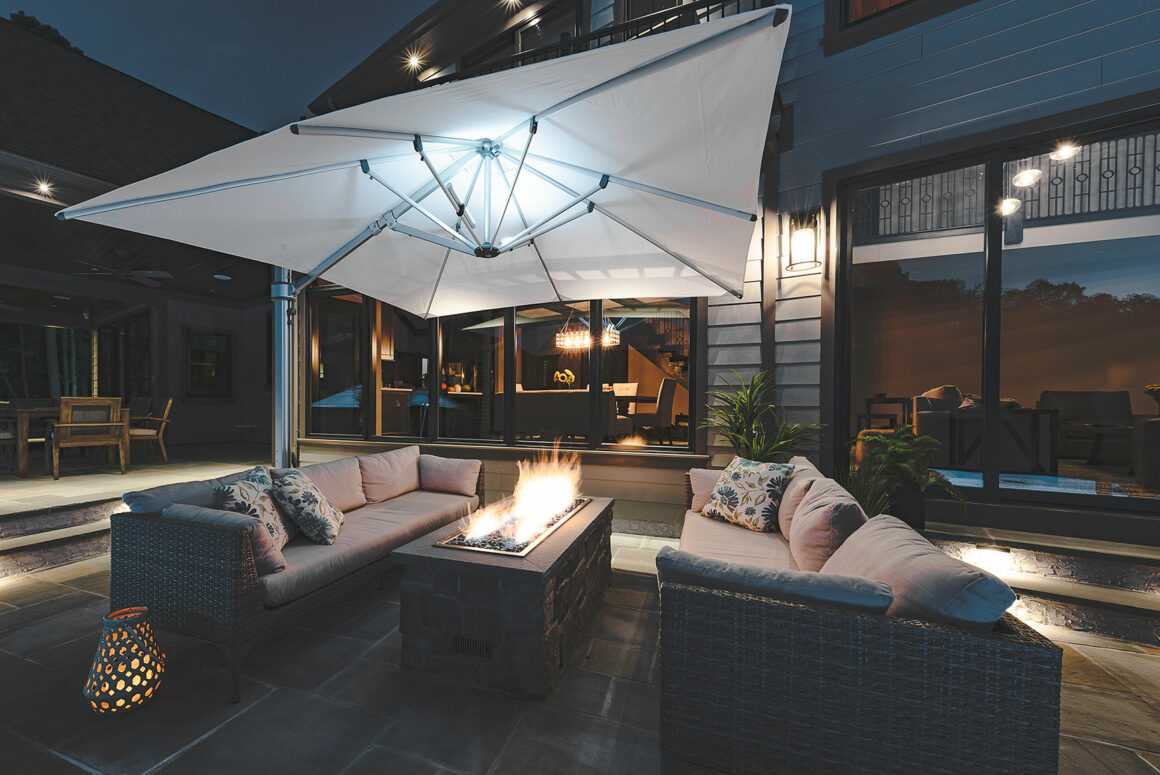
Outdoor Dining Tables with Parasol Holes
Shop Curran’s selection of outdoor dining tables with parasol holes. Most often found in models with teak table tops, Barlow Tyrie and Gloster, in particular, offer a number of collections with rustic and modern teak sensibilities for the ultimate garden retreat.
Examples: Gloster Split, Gloster Carver, Barlow Tyrie Equinox, Barlow Tyrie Aura
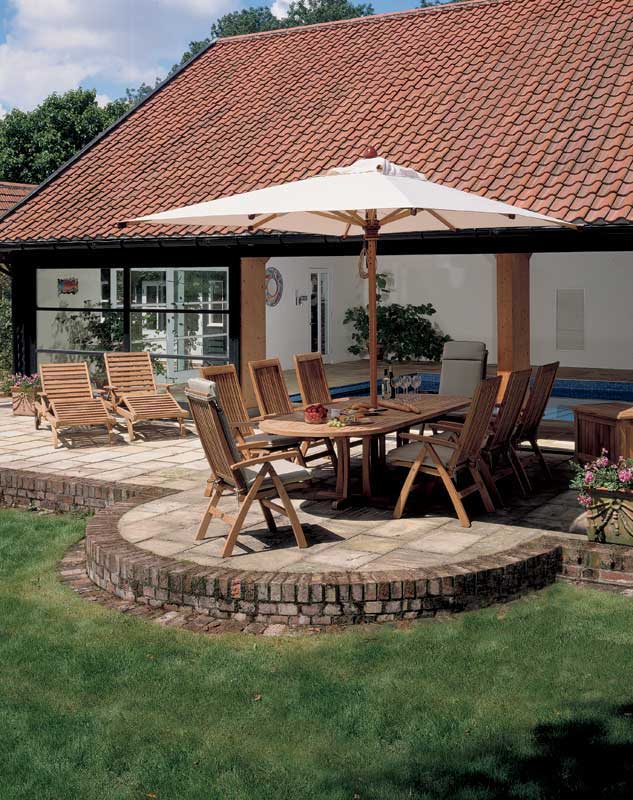
Further Reading:
JAS Design Build: An interesting post about the holistic intersection of home architectural design services and the finishing details of a project down to the interior design aesthetic and curation of specific furnishings.
Blue Haven Pools & Spas: Advice for furnishing and decorating a poolside patio.
Toll Brothers: A comprehensive resource for laying out furnishings for pools, patios, fire pits and more.
Umbrosa: One of our brands was represented recently at the Salone 2022 exhibition in Milan. Check out this video which captures the elegant visual poetry of these umbrella models in action.
Paul is the Outdoor Furniture Storyteller at Curran and sisalcarpet.com. For the past 2 years he has been focused on crafting content that helps connect those who enjoy the finer things in life with heirloom outdoor furniture pieces. With over a decade of experience in e-commerce and web publishing, he envisions Curran as a comprehensive destination for building dream outdoor spaces. His favorite furniture style? Mid-Century Modern (it kind of encompasses a little bit of everything :D).


